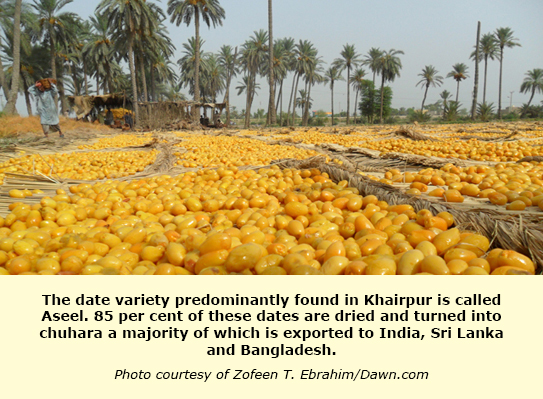Unidentified virus has caused killing of date trees in Khairpur district, triggering a wave of panic among the date producers.
Information gathered from farmers and researchers associated with Sindh Agriculture University Tandojam, Agriculture Training Institute Sakrand and agriculture extension department revealed that nobody is capable enough, despite collecting soil samples from plant roots, to identify the exact problem: maybe it is soil nutrient deficiency, soil-borne disease or anything else, which are making trunk and trees dying one after another.

Agriculture scientists, however, agreed on one point that soil nutrient deficiency is increasing, affecting crops yield, killing fruit orchards and trees in Sindh.
The scientists said growing trend of multi-cropping might also be causing the problem with even strong and drought-resistant date trees also dying.
Usually, farmers practice multi-cropping in farms of banana, wheat, maize, rice, and vegetables despite the practice is considered harmful to soil fertility.
In the district, numerous date gardens are as old as 60 to 80 years. Some trees standing in scattered areas are even 100-year old, but they are still bearing fruits.
After witnessing the losses, farmers are seen reluctant to plant new date trees as each plant takes at least five to seven years to be matured and bear fruits.
“The practice of establishing new date gardens has completely been stopped,” a frightened farmer told this scribe. Rasool Bakhsh Khaskheli, a researcher at Agriculture Training Institute Sakrand said a number of farmers have lost their date farms.
“Some farmers cut the virus-affected trees instantly to save others believing the disease may kill all the trees,” Khaskheli, who belongs to Khairpur district, added. “They cut but do not plant saplings at the place of dead one to rehabilitate the old gardens.”
Khaskheli is leading a project to promote green manure to restore soil fertility in four districts, including date-producing Khairpur.
“The virus first hit the Khairpur date farms 4 to 5 years ago and now it is endemic, annihilating date gardens,” he said. Alone highly drought-resilient date tree can survive harsh dry weather and without water for long but soil nutrient deficiency couldn’t let them live too.
Researchers said it is an old practice that farmers do not give additional supplements to maintain soil nutrients and save old date orchards. Yet, the emerging threat has added to miseries of the farmers, who presently do not have any other option than shifting to other crops, they added.
Date farmers said if the virus continues to harm tall trees the date production may decline and worsen vulnerability of a large number of producers and workforce, who solely depend on the short-period product for livelihoods.
One acre of land has at least 40 date trees and each tree carries 18 to 25 bunches, giving output of up to 120 kilograms.
Date farmers said they are already facing price fluctuation, uncertain monsoon rains and heat wave at the ripening stage, which damages the product, leaving workers in helpless situation.
The temperature reaches 48 to 51 Celsius during the harvest season. People flee the area to avert scorching heat.
Presently, date products are not being exported to neighbouring countries due to unstable political relationship.
An entire season of date harvesting, picking, processing and packing takes up to 45 days.
Date harvest season starts from mid-July to August that attracts a large number of workers from different districts of Sindh, Punjab and Balochistan, who stay there for the entire season.
Usually, outside workers start migration from their native areas in late May and June to date gardens for picking, drying, boiling, processing and packing. But, the newly emerging situation of killing trees may affect their source of income.
They earn daily wages from Rs300-500, depending on the market situation. Date provided high-energy food to the people and source of income to farmers, labourers, traders and transporters. A large number of skilled women also depend on the date trees, taking leaves for different byproducts and earn enough to supplement their family income.
There are more than 300 date leaves facilities in Khairpur district. A large number of skilled women are involved in manufacturing variety of hand-made items, including floor mat, basket, hand fans, hot pots, hand bags, door blinds and many other items, which are famous among consumers.
The craft has a long history with artisan women making innovative designs. Previously, Khairpur district was the fourth largest manufacturer of date leaves-made products in the country. Now, the major reason of low production is decline in demand, while artisans do not produce a big variety of items that are suitable for urban market.
Khairpur’s date palm business is largely dependent on women workforce who, due to their controlled mobility, cannot directly join the industry and are forced to work from home.
Since the formal industry is underdeveloped such womenfolk is becoming increasingly important to keep the handicraft business running. Fast depletion of date trees may also affect the valuable craft by boosting prices of raw materials. Researchers urged the government to identify the problem and immediately cope up with the situation.
Written by Jan Khaskheli, The News
